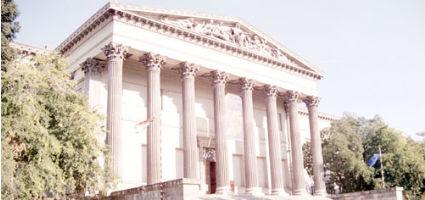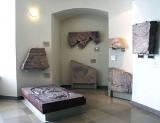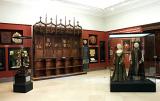2025. July 11. Friday
Hungarian National Museum - Budapest
 |
Address: 1088, Budapest Múzeum körút 14-16.
Phone number: (1) 338-2122
E-mail: info@hnm.hu
Opening hours: Tue-Sun 10-18
|
The Hungarian National Museum is a museum of history. Its task is to collect, preserve, and process the historical material in connection with Hungary and its introduction to the people. This process has been practiced for over 200 years by the museum.
The foundation of the museum coincided with significant changes in the course of Hungarian history, the development of the national consciousness of the New Age, the spreading of the civic notion of freedom. In 1802 the Count Ferenc Széchényi asked for permission from the Emperor to give his collection in connection with Hungary to the nation. He received permission, thus we take this time to be the year of the foundation of the Hungarian National Museum.
In 1807 The Hungarian Parliament nationalized the new institution and asked the nation to donate. One of the most valuable donations was that of the wife of the founder, Julia Festetics's mineral collection, which provided the basis for the Hungarian Natural History Museum.
Beside the donations and help, the Hungarian Parliament of 1832-34 voted for giving half a million forint for building a new building for the Museum. Prince Antal Grassalkovich donated the building-site where the museum was built. Later the site was exchanged for the property where the museum is situated today.
Mihály Pollack, a significant figure of the Hungarian classicist architecture was assigned to do the architectural works which lasted from 1837-47. The statues of the tympanum over the portico are the works of Raffael Monti of Milan. The walls of the staircase and the ceiling have the paintings of Károly Lotz and Mór Than on them since 1875.
The museum played an important role in the Revolution of 1848-49. Sándor Petőfi recited his poem for the People who assembled in front of the museum. This was the initiating event of the revolution. From this time the National Museum is not only the most important place of collections but also the symbol of national identity and progress.
To create an aesthetic environment a garden was planned and concerts were held by artists like Ferenc Liszt to collect the necessary amount. The statue of János Arany was revealed in 1883, the memorial tablet of Petőfi was placed on the right side of the staircase in 1890.
At the end of the 19th century numerous scientists worked for the museum. The ever developing collection was already too big for the museum. The international museology also developed in the direction of creating its adequate departments. This is how for example the Museum of Applied Arts was founded in 1872, and the Museum of Fine Arts in 1896.
Though the building was totally renovated in 1926-27, WWII caused serious damages in it which were repaired by 1948.
Beside the Széchényi Library, the Museum of Ethnography and Natural Sciences separated in 1949. The supervision of important institutions such as the Matias Rex Museum of Visegrád, the Rákóczi Museum of Sárospatak was entrusted to the National Museum from the 1960s.
The foundation of the museum coincided with significant changes in the course of Hungarian history, the development of the national consciousness of the New Age, the spreading of the civic notion of freedom. In 1802 the Count Ferenc Széchényi asked for permission from the Emperor to give his collection in connection with Hungary to the nation. He received permission, thus we take this time to be the year of the foundation of the Hungarian National Museum.
In 1807 The Hungarian Parliament nationalized the new institution and asked the nation to donate. One of the most valuable donations was that of the wife of the founder, Julia Festetics's mineral collection, which provided the basis for the Hungarian Natural History Museum.
Beside the donations and help, the Hungarian Parliament of 1832-34 voted for giving half a million forint for building a new building for the Museum. Prince Antal Grassalkovich donated the building-site where the museum was built. Later the site was exchanged for the property where the museum is situated today.
Mihály Pollack, a significant figure of the Hungarian classicist architecture was assigned to do the architectural works which lasted from 1837-47. The statues of the tympanum over the portico are the works of Raffael Monti of Milan. The walls of the staircase and the ceiling have the paintings of Károly Lotz and Mór Than on them since 1875.
The museum played an important role in the Revolution of 1848-49. Sándor Petőfi recited his poem for the People who assembled in front of the museum. This was the initiating event of the revolution. From this time the National Museum is not only the most important place of collections but also the symbol of national identity and progress.
To create an aesthetic environment a garden was planned and concerts were held by artists like Ferenc Liszt to collect the necessary amount. The statue of János Arany was revealed in 1883, the memorial tablet of Petőfi was placed on the right side of the staircase in 1890.
At the end of the 19th century numerous scientists worked for the museum. The ever developing collection was already too big for the museum. The international museology also developed in the direction of creating its adequate departments. This is how for example the Museum of Applied Arts was founded in 1872, and the Museum of Fine Arts in 1896.
Though the building was totally renovated in 1926-27, WWII caused serious damages in it which were repaired by 1948.
Beside the Széchényi Library, the Museum of Ethnography and Natural Sciences separated in 1949. The supervision of important institutions such as the Matias Rex Museum of Visegrád, the Rákóczi Museum of Sárospatak was entrusted to the National Museum from the 1960s.

